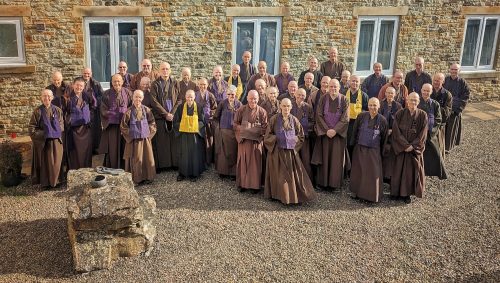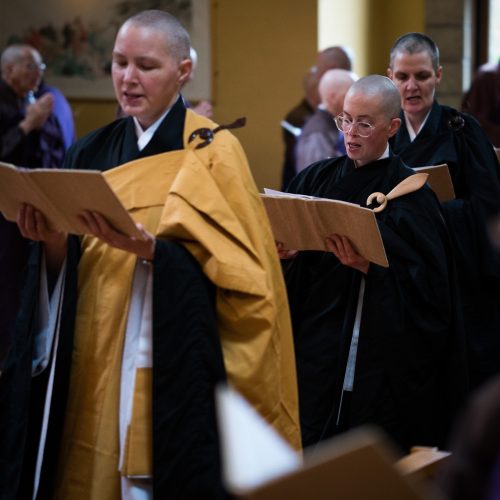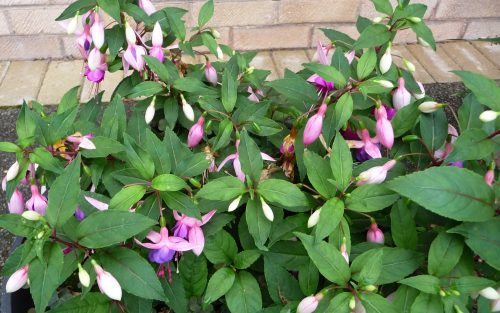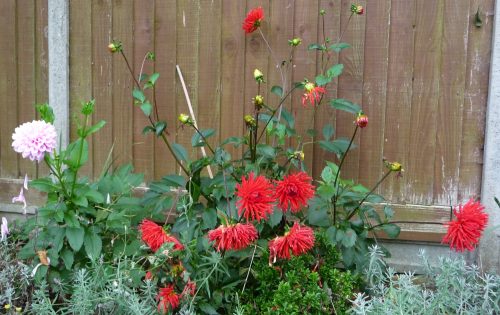October 2023 Newsletter
Monastic Gathering at
Throssel Hole Buddhist Abbey
As many of you know, Turning Wheel Buddhist Temple is part of a larger organisation, the Order of Buddhist Contemplatives (OBC), which is an umbrella organisation for monks and temples in the lineage of Rev. Master Jiyu Kennett. The order has temples in the US, Canada, Germany, the Netherlands and Latvia, as well as here in the UK. With such a wide geographic spread it is important that we meet together regularly, and we currently have monastic gatherings every other year, with the venue alternating between the UK and the US.
The gathering this year was at Throssel Hole Buddhist Abbey in Northumberland, and I travelled up there in mid-September for a couple of weeks. The previous gathering had been scheduled to be held at Shasta Abbey in California in September 2021, but unfortunately had to be cancelled due to Covid restrictions, so the last time we met together in this way was at Throssel in September 2019.
Although the weather was quite wet and windy when we arrived, and again towards the end of our stay, it was very nice to have several dry, still days in the middle of the gathering, and the grounds at Throssel were looking very green and lush, with some of the plants around the buildings still in flower.
There were 46 monks at the gathering altogether, and below is a group photo taken on the last day of the gathering, in the courtyard just below the room in which we were meeting.

On most mornings of the gathering we had group discussions in the library. We discussed a number of different issues to do with the order and how things are going, and it was a great opportunity to hear from different monks throughout the order.
The sessions were led by Rev. Master Haryo, the head of the order, assisted by a facilitator and a time-keeper to help the discussion flow easily and to allow anyone to make a contribution who wanted to. This was slightly more involved than at previous meetings, as a number of monks who couldn’t make it in person joined the sessions via zoom. For the morning sessions it wasn’t practical for monks from North America to join via zoom, as it was the middle of the night there. However, we also had hour-long sessions at 4pm (which was 8am on the west coast) which quite a few North American monks joined, both from Shasta Abbey and from smaller US and Canadian temples.
The early part of each afternoon was left open, which allowed monks time to catch up with those from other temples, and other countries, who they may not have seen for several years, and to have a cup of tea together, or go for a walk around the grounds or along the road. Although having a cup of tea together may not seem that important, connections like this really help to maintain the cohesiveness of an order that is spread over several countries on two continents.
During the gathering we also had a couple of days off from discussions, and many of the visiting monks had a chance to see some local places of interest, including the Roman site at Vindolanda (near Hadrian’s Wall), the Lake District and Lanercost Priory in Cumbria, as well as to go on some local walks in and around the valley.
Seven monks of the order had died since we last met in 2019, and we remembered them during the time that we were together. The seven monks were Rev. Master Jisho Perry, Rev. Master Teigan Stevens, Rev. Master Saido Kennaway, Rev. Master Myfanwy McCorry, Rev. Master Meiko Jones, and Rev. Renée Doak. During the gathering we held a memorial ceremony for them all, and the photo below is of monks circumambulating during that ceremony.

One of the things that we discussed during the meetings was changing some of the wording of our scriptures in order to make them more gender-neutral. Selecting wording is a tricky task, as certain words may have implications for some people that aren’t there for other people, and it was helpful to have so many different monks express their thoughts on the effects of different changes. We made several changes to The Scripture of Great Wisdom, The Most Excellent Mirror – Samadhi and The Litany of the Great Compassionate One, as well as smaller changes to one of the Vespers invocations and the mealtime ceremonial.
A new booklet with the updated wording is being worked on, and it was agreed that new recordings of the affected scriptures would also be made. This will be particularly useful for those temples which use recordings during events that are held over zoom, for example.
We were all very grateful to the community of Throssel Hole for proving accommodation and meals for so many visitors, and to Rev. Master Haryo and all those who helped to organise the event. Thanks also to Rev. Lambert, who took the photos above.
The next gathering will probably be in Spring 2026 at Shasta Abbey in California.
with best wishes
Aiden
Forthcoming Events:
The Festival of Great Master Bodhidharma
On Saturday the 7th of October we will be celebrating the Festival of Great Master Bodhidharma. Bodhidharma is an important figure within Zen, as he is credited with bringing the meditation school of Buddhism from India to China. His emphasis on “pure meditation”, and the need to spend time “just sitting” facing a wall, are still central to our tradition. This festival is an opportunity to celebrate the life of Bodhidharma and to focus on some of his important teachings.
In addition to welcoming visitors to the temple for the festival (please book in advance), we will also be holding the festival over zoom so that Lay Sangha members can join in from where they are. Full details of the festival day will be sent out by email to Lay Sangha members prior to the festival.
The festival day will run from 10am to 4pm, with the Festival and Dharma Talk both in the morning so that people can come just for those if they would prefer. There will then be the option to stay on for a bring-and-share lunch and an afternoon of meditation, followed by tea and biscuits and an opportunity to ask questions.
Buddhist Stories
There are many stories in Buddhism, from the time of the Buddha onwards, and they are very helpful in illustrating aspects of the Buddha’s teaching and Buddhist practice.
Shariputra meets a Goddess
Part 2: Embodying emptiness
This story is from the Vimalakirti Sutra, a scripture in the Mahayana Buddhist tradition which was perhaps written at the end of the 1st century CE. The central character is the lay person Vimalakirti, who is portrayed as being profoundly enlightened. He has trained very deeply in Mahayana Buddhism, and in the early part of the scripture many of the Buddha’s disciple describe how they have been shown up by his deeper understanding of the teaching.
Following the incident with the flowers (see part 1), Shariputra continues to talk with the goddess, asking her lots of questions about her practice. She answers them very fully and eloquently, and Shariputra is clearly impressed by her wisdom. Shariputra apparently thinks that, since the goddess has the power to make herself visible or invisible, she must also have the power to appear in any form she wants, and assumes that, if this is the case, then she would of course prefer to be male rather than female. (In reading the scripture it’s important to realise that it was written several centuries after the time of the Buddha, and that the real Shariputra never thought, said or did any of the things attributed to him in the scripture. The character of Shariputra is simply being used to help bring out the meaning of the teaching that is being offered. Similarly, the inclusion of the character of the goddess doesn’t imply that Buddhism teaches or believes that there really are such beings; it is just helpful to the story to have a character who has ‘powers’ that ordinary humans don’t have.)
In the middle of their Dharma discussion, after the goddess has given him a very detailed answer to one of his questions, she asks Shariputra a question in return, but he completely ignores her and abruptly changes the subject by suddenly asking her, “Why don’t you change from being female?”
The goddess doesn’t take offence at this rather impolite and personal question, but straightforwardly replies, “For many years now I have been trying to track down within myself an essence of being female, but I haven’t yet managed to find any such thing, so what exactly is it that you want me to change?”
To illustrate the point that she is making, the goddess continues by asking Shariputra, “If a magician were to conjure up an illusory woman, would you ask her why she didn’t change from being female?”
“No,” replied Shariputra. “Illusory beings have no fundamental reality, so what would there be to change?”
The goddess said, “Exactly so, and that is actually how it is for all things; they don’t have a fixed substantial self or unchanging essence. Since I too have no fixed self-nature, how could it be either male or female? Why then do you ask me about changing my female nature, when there is fundamentally no such thing?”
At the beginning of the chapter, before the goddess appeared, Manjusri had asked Vimalakirti, “How does a Bodhisattva see living beings?” Vimalakirti replied in a way similar to the goddess, saying, “A Bodhisattva should see living beings in just the same way as conjurers look on the phantom creations which they conjure up. It is the same way that the wise view the moon in the water, or a face seen in a mirror.”
Vimalakirti was explaining the Buddha’s teaching of ‘anatta’, or no-self, in which the Buddha clearly states that there is no unchanging, permanent self, soul or essence, and that this is true not just of human beings, not just of all living things, but of all phenomena. Vimalakirti continues to give many more similes to illustrate how we should see beings in terms of no-self, and it is this theme that the goddess picks up again in her conversation with Shariputra.
The Buddha’s teaching of anatta is the basis for the teaching of emptiness, which is an important aspect of Mahayana Buddhism. The goddess is trying to get Shariputra to see how the teaching of emptiness applies in practice by explaining that she can’t change her fundamental nature because there is no such thing. She is not to denying that she has a female bodily form, just pointing out that this doesn’t mean that there is some fundamental essence in her which is inherently female, and which might be changed into being male.
***
The goddess perhaps suspects that Shariputra hasn’t completely taken on board the teaching that she has been offering, so she uses her magical powers to carry out some physical transformations which can’t help but grab Shariputra’s attention, and get him to engage with the teaching.
What the goddess does is to use her powers to change Shariputra into a goddess just like her, and at the same time changes herself into the form of Shariputra. Then she asks Shariputra, “So why don’t you now change your female nature?”
Shariputra, who now suddenly finds himself in the form of a goddess, isn’t even able to engage with the goddess’s question, and simply says, “I have no idea how this happened; how have I suddenly ended up in this female body?”
Seeing that Shariputra is too shocked to reply, the goddess explains to him the teaching that this transformation highlights. She says, “Shariputra, if you are now able to change your female nature, then all women should be able to change theirs as well. This isn’t possible though, because Shariputra, although he has the appearance of a female bodily form, doesn’t actually have the essence or nature of a woman.” She then points out that this is equally true for all women as well, saying, “Although those who we refer to as women do undoubtedly appear in women’s bodies, they don’t actually have any essence or nature of a woman. This is an example of the Buddha’s teaching that all phenomena are neither male nor female, and this in turn is because they don’t actually have a fixed essence or nature that could be either male or female.”
Perhaps sensing that Shariputra was about to be overwhelmed by his present experience, the goddess then withdrew her magical powers just as quickly as she had used them, and Shariputra found himself back in his original body. The goddess, however, was keen to establish what Shariputra had learnt from the experience, and asked him, “So where is your female nature now?”
Shariputra replied, “I can’t exactly say; I can’t say that my female nature exists, and yet I can’t say that it doesn’t exist either.”
The goddess approves of Shariputra’s answer, and clearly thinks that he now has a better understanding of the teaching of emptiness. She says, “All things are just like this—they do not exist, but do not not exist. And the fact that they simultaneously do not exist, yet do not not exist, is just what the Buddha teaches.”
In a final exchange on the subject of emptiness, Shariputra then asks the goddess where she will be reborn once her present life is over. She replies that she will be born in the same way that Buddhas are born when they take on a “transformation body” in order to guide and teach beings. Shariputra is familiar with this teaching and objects, saying, “When a Buddha is born in a transformation body, it is not a matter of birth or death.” The goddess replies, “Exactly so, and it’s just the same for all living beings too; they are without birth and death because there is no fundamental entity or essence that could be born or could die.”
***
With our twenty-first century sensibilities it is very easy to see this interchange between Shariputra and the goddess in terms of equality between men and women, and of course the writer of the scripture is drawing our attention to this issue in having Shariputra clumsily suggest that a woman would rather be a man. The goddess herself isn’t talking about equality issues though, or about transgender issues, she is pointing at something much deeper and more fundamental in the Buddha’s teaching; that all things are empty of self-nature, and have no fixed unchanging essence.
We all have a sense of self, which is why the Buddha put such an emphasis on explaining that just because we have a sense of self doesn’t mean that we actually have a fixed unchanging essence that is that self; it just seems like we do. Although it seems like we do, when we try to pin down exactly what or where it is, then like the goddess we are unable to track down any such thing within ourself. If we believe that we have a self, soul or essence that is the ‘real us’ then we will tend to try to build up and protect that self. But this is a state of suffering and can lead us to act in ways that harm others, because we tend to feel that we have to get what we need for this self whatever the cost to others.
If, on the other hand, we can accept that the sense of self that we feel doesn’t imply a fixed entity, then we can live in the world as this body and mind (however we think of it or describe it to ourselves) without setting up a conflict in our mind between ourselves and others. Then we can live at ease within this body and mind. In the story, Shariputra has the advantage of a goddess helping him to see and experience this truth directly. We don’t have this advantage, so like the goddess we need to really pay attention to ourselves, and investigate the truth of this teaching within our own body and mind. Perhaps after much fruitless searching for ‘the essence of me’ we will be able to accept the teaching of emptiness, let go of the ‘suffering separate self’ which always has to fight it’s own corner, and live as an integrated part of the Life of Buddha that is the life of the whole universe.
***
Sources:
There are several different translations of the Vimalakirti Sutra. The version of the story above is mainly based on the translation by Burton Watson:
Watson, Burton. The Vimalakirti Sutra. Columbia University Press, 1997. ISBN 9780231106566
See also the translation by Charles Luk (Lu K’uan Yü):
Lu, Kuanyu. Ordinary Enlightenment: A Translation of the Vimalakirti Nirdesa Sutra. Shambhala, 2003. ISBN 1570629714
Some photos from the garden
Despite the recent stormy weather we still have several plants flowering in the temple garden.
Just outside the temple front door we have a tub of fuchsias which are in full flower at the moment. Further over in the front border the dahlias are in flower too, with many more still to come. Hopefully the current warm weather will continue long enough for the remaining flower buds to bloom properly.


Alms Bowl Requests
Donations of Food
Offering food is a traditional way to support a monk, and all donations of vegetarian food are most welcome. In particular:
- porridge oats
- peanuts or other nuts
- peanut butter
- fresh fruit and vegetables (except garlic or peppers)
- dried herbs
- cheese, eggs and yoghurt
Any other suitable items would also be appreciated.
Donations
The temple is dependent on donations for its continued existence, and any financial support you are able to offer is greatly appreciated. Details of how to offer support can be found on the Donations page of the website.
All donations are received with gratitude



